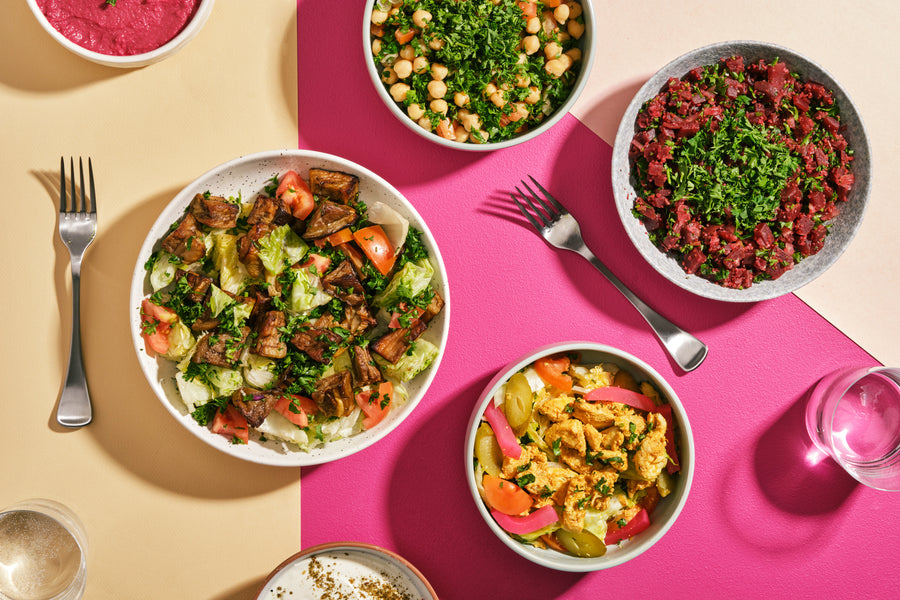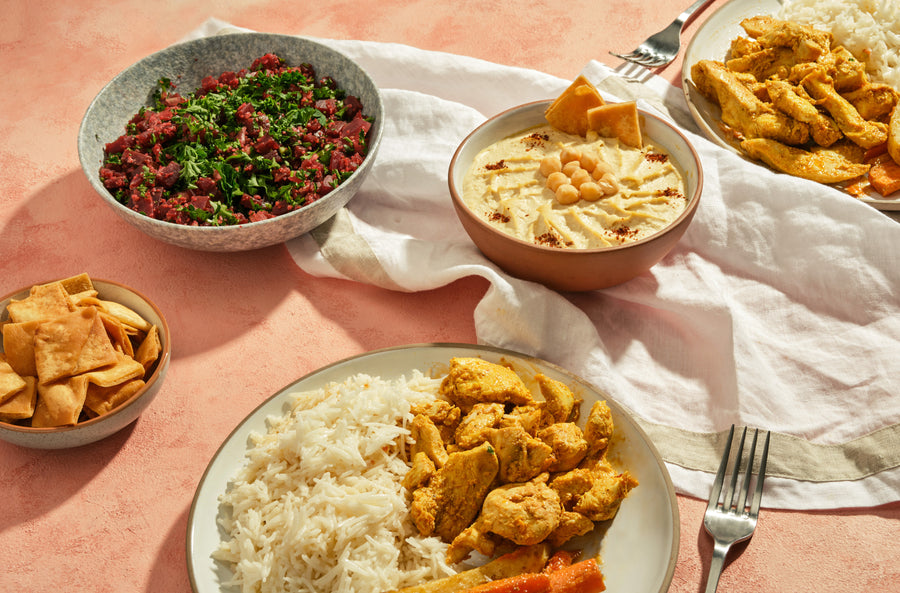All Concerning the Rich Flavors and Traditions of Syrian Cuisine: A Culinary Journey
Syrian cuisine supplies an unique mix of tastes and practices that mirror its rich cultural background. With staple components like olive oil and garlic, alongside a selection of seasonings, the dishes are both diverse and welcoming. From the complex preparation of kibbeh to the pleasant allure of baklava, each element of this culinary landscape reveals much deeper stories. As one explores the significance of these tastes, a higher understanding of communal dining and event emerges.
The Significance of Syrian Ingredients
The significance of Syrian components depends on their abundant variety and ingrained cultural relevance. Influenced by the country's varied location and history, Syrian cuisine incorporates a vast variety of flavors, herbs, and fresh produce. Staples such as olive oil, garlic, and lemon supply a foundation, while seasonings like coriander, sumac, and cumin add depth and intricacy to dishes.The use of fresh herbs, consisting of parsley and mint, highlights the value of seasonal ingredients. In addition, the region's fertile dirt yields a wealth of vegetables and fruits, such as eggplants, pomegranates, and tomatoes, which are essential to many recipes. Grains like bulgur and rice develop the base of many dishes, underscoring the relevance of these ingredients in Syrian society. This mix of tastes mirrors not simply a cooking tradition but likewise a tapestry of historical influences, making Syrian components vital to understanding its food's vivid character.

Iconic Dishes of Syrian Cuisine
Syrian food is renowned for its famous dishes that showcase an abundant tapestry of textures and tastes. Typical meze plates supply a variety of tiny recipes that tantalize the palate, while hearty primary courses supply rewarding focal points for dishes (Afternoon Tea Vancouver). To complete the experience, a choice of savory treats includes a pleasant note to the cooking trip
Typical Meze Plates

Hearty Main Courses
Passionate major training courses work as the focal point of Syrian dining, showcasing a mix of tastes that mirror the country's abundant cooking traditions. Dishes such as kebab hindi, including marinated lamb skewers, and the popular mujaddara, a reassuring combination of lentils and rice, highlight the use of aromatic seasonings and fresh components. An additional staple is the renowned kibbeh, made from bulgur wheat and minced meat, frequently offered in numerous types, including baked, deep-fried, or raw. Additionally, the tastes of the land come active in meals like stuffed vegetables, understood as mahshi, which are full of rice, meat, and natural herbs. These main dishes not just please hunger yet additionally tell stories of family members events and social heritage.
Delightful Desserts Choice
A fascinating variety of treats defines the wonderful side of Syrian food, providing an alluring end to any type of dish. Amongst one of the most well known confections are baklava, delicate layers of phyllo bread full of nuts and soaked in syrup, and maamoul, shortbread-like cookies often packed with dates or nuts. Knafeh, a rich treat made from slim noodle-like pastry taken in syrup and layered with cheese, is a popular option, particularly during joyful occasions. Additionally, the wonderful and great smelling rice dessert, referred to as roz bil laban, offers a comforting finish. These savory desserts not only showcase the region's cooking proficiency but likewise mirror the social heritage of Syria, making them cherished deals with in both dining establishments and homes alike.
Standard Food Preparation Methods
Modern-day comforts have actually influenced numerous culinary methods, traditional cooking strategies stay vital to Syrian cuisine. These approaches commonly emphasize making use of fresh, seasonal components and concentrate on slow cooking to establish abundant flavors. Methods such as barbecuing, braising, and stewing are common, enabling the all-natural tastes of the components to beam through.One noteworthy method is the preparation of kibbeh, a dish made from finely ground meat and bulgur. It requires competent hand-rolling into various forms and can be baked, fried, or served raw. In addition, the art of making bread, specifically pita, is main to lots of dishes, usually cooked in a conventional stone oven.Preservation techniques like pickling and fermenting also play an essential role, enhancing the variety of flavors discovered in Syrian dishes. These methods not only show the region's farming heritage yet also promote a strong sense of community via shared cooking techniques.

The Function of Spices in Flavor
Seasonings work as the heartbeat of Syrian food, infusing recipes with complex flavors and fragrant depth. Each seasoning plays a crucial role, contributing not just to taste yet likewise to the social heritage of the region. Generally used flavors include cumin, sumac, and coriander, each providing an unique account that boosts standard dishes. Cumin provides heat and earthiness, while sumac includes a tasty brightness, improving the overall dish.Syrian chefs frequently mix spices to develop unified profiles, reflecting the intricate balance of flavors that specify the food. Using spices is not just for seasoning; it also offers to maintain food and improve its nutritional value. This thoughtful consolidation highlights a deep understanding of the culinary arts, where flavors come to be important authors, conveying the abundant history and diverse impacts that identify Syrian gastronomy. Ultimately, flavors are vital in crafting remarkable and genuine Syrian dishes.
Celebratory Dishes and Cheery Custom-mades
Celebratory dishes in Syrian cuisine are noted by typical feast dishes that reflect the country's abundant culinary heritage. Special celebrations typically involve unique rituals that improve the communal experience of eating. These customs not just honor the my response value of the occasions however likewise enhance social and domestic bonds.
Traditional Feast Dishes
When family members collect to celebrate substantial events in Syria, traditional feast recipes take facility phase, showcasing the abundant cooking heritage of the region. These events frequently include vibrant plates of mezze, consisting of hummus, baba ghanoush, and tabbouleh, which serve as wonderful starters. The main training course generally highlights lamb or hen, marinaded and cooked to perfection, commonly gone along with by great smelling rice pilaf or bulgur. One of the most beloved recipes is maqlooba, a layered rice recipe with vegetables and meat, turned upside down prior to offering. Sugary foods also play a crucial duty, with baklava and knafeh using a wonderful surface to the meal. Each recipe not only delights the palate however likewise reflects the deep-rooted practices and public spirit of Syrian society.
Special Event Rituals
Special events in Syria are marked by rich routines that intertwine food and celebration, showing the cultural relevance of communal events. Celebratory meals frequently include standard meals such as kibbeh, tabbouleh, and different grilled meats, prepared with care and shared amongst family and pals. During spiritual holidays like Eid al-Fitr and Eid al-Adha, family members collaborated to prepare special desserts like maamoul, symbolizing unity and pleasure. Wedding events are particularly my review here sophisticated, featuring several training courses and lively display screens of friendliness. These occasions are not simply concerning food; they encompass dance, storytelling, and songs, reinforcing social bonds and social heritage. Via these rituals, Syrians celebrate life's turning points, making sure customs are passed down with generations, enhancing their cooking landscape.
The Importance of Sharing and Neighborhood
Sharing meals is a basic element of Syrian society, reflecting the deep-rooted values of community and link. In Syria, food is not just nutrition however a way of bringing individuals together. Pals and households gather around the table to enjoy traditional recipes, promoting bonds and developing long lasting memories. This communal dining experience stresses hospitality, where hosts most likely to excellent lengths to assure every guest feels welcomed and nourished.The act of sharing food likewise represents kindness and uniformity, reinforcing social connections within neighborhoods and larger neighborhoods. Throughout events, it prevails for individuals to offer each other, showcasing a spirit of togetherness that goes beyond distinctiveness. Parties, whether huge or tiny, are commonly marked by the sharing of meals, where varied tastes and dishes integrated, showing the abundant tapestry of Syrian culture. Appropriately, the significance of sharing and neighborhood in Syrian cuisine is not only a cooking practice yet an important social practice.
A Culinary Expedition of Syrian Sweets
Although usually overshadowed by mouthwatering recipes, Syrian desserts hold a valued area in the nation's cooking heritage. These confections show the region's abundant background, blending tastes and techniques from various cultures. Traditional desserts like baklava, with its layers of phyllo bread, nuts, and honey syrup, display the creativity associated with Syrian cooking. Ma'amoul, a shortbread-like cookie loaded with dates or nuts, is often gotten ready for cheery events, representing friendliness and celebration.Another beloved wonderful is Knafeh, a pastry taken in syrup and layered with cheese or lotion, using a delightful contrast of structures. Syrians also enjoy a range of fruit syrups and preserves, frequently served with tea or as component of a bigger spread throughout events. These sugary foods not only please the taste buds however also function as a bridge between generations, preserving the traditions and stories of Syrian culture through each mouth-watering bite
Often Asked Inquiries
What Are the Wellness Perks of Traditional Syrian Foods?
The wellness benefits of typical Syrian foods include rich nutrients from fresh vegetables, vegetables, and whole grains. These components promote heart wellness, improve food digestion, and offer essential vitamins, contributing to total health and a well balanced diet plan.
Exactly How Has Syrian Cuisine Evolved Over the Years?
Syrian cuisine has actually advanced substantially, affected by historical trade paths, social exchanges, and regional accessibility of ingredients. Standard recipes have integrated contemporary tastes and techniques while preserving their abundant heritage, mirroring a varied culinary landscape.
Are There Vegetarian or Vegan Options in Syrian Food?
Syrian cuisine uses many vegan and vegan alternatives, featuring recipes like falafel, tabbouleh, and packed grape fallen leaves. These dishes highlight look at here now the region's rich farming heritage, showcasing fresh vegetables, grains, and fragrant seasonings in lively mixes.
What Beverages Set Well With Syrian Recipes?
When considering beverages that match Syrian dishes, one might discover that mint tea, pomegranate, and ayran juice improve the dish's tastes. In addition, merlot commonly sets well with the seasonings generally located in these foods.
Just How Can I Recreate Syrian Dishes in the house?
To recreate Syrian dishes in the house, one need to explore authentic recipes, gather traditional ingredients, and utilize food preparation strategies one-of-a-kind to the food. Trying out spices and discussion also improves the total dining experience. Syrian cuisine is renowned for its legendary dishes that showcase an abundant tapestry of tastes and textures. Seasonings offer as the heart beat of Syrian cuisine, infusing dishes with complex tastes and aromatic deepness. Celebratory dishes in Syrian food are marked by traditional feast recipes that mirror the nation's rich culinary heritage. Parties, whether big or little, are commonly marked by the sharing of dishes, where diverse flavors and recipes come with each other, reflecting the abundant tapestry of Syrian society. Syrian food provides numerous vegan and vegan alternatives, featuring dishes like falafel, tabbouleh, and packed grape fallen leaves.